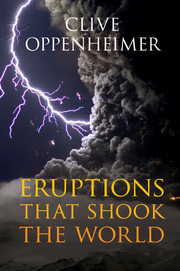Book contents
- Frontmatter
- Contents
- Preface
- Acknowledgements
- 1 Fire and brimstone: how volcanoes work
- 2 Eruption styles, hazards and ecosystem impacts
- 3 Volcanoes and global climate change
- 4 Forensic volcanology
- 5 Relics, myths and chronicles
- 6 Killer plumes
- 7 Human origins
- 8 The ash giant/sulphur dwarf
- 9 European volcanism in prehistory
- 10 The rise of Teotihuacán
- 11 Dark Ages: dark nature?
- 12 The haze famine
- 13 The last great subsistence crisis in the Western world
- 14 Volcanic catastrophe risk
- Appendix A Large eruptions
- Appendix B Further reading and data sources
- References
- Index
3 - Volcanoes and global climate change
Published online by Cambridge University Press: 01 June 2011
- Frontmatter
- Contents
- Preface
- Acknowledgements
- 1 Fire and brimstone: how volcanoes work
- 2 Eruption styles, hazards and ecosystem impacts
- 3 Volcanoes and global climate change
- 4 Forensic volcanology
- 5 Relics, myths and chronicles
- 6 Killer plumes
- 7 Human origins
- 8 The ash giant/sulphur dwarf
- 9 European volcanism in prehistory
- 10 The rise of Teotihuacán
- 11 Dark Ages: dark nature?
- 12 The haze famine
- 13 The last great subsistence crisis in the Western world
- 14 Volcanic catastrophe risk
- Appendix A Large eruptions
- Appendix B Further reading and data sources
- References
- Index
Summary
Had the fierce ashes of some fiery peak
Been hurl'd so high they ranged about the globe?
For day by day, thro' many a blood-red eye …
The wrathful sunset glared.
Tennyson, St. Telemachus (1892)‘For those trying to understand the natural and anthropogenic processes for global change, the eruption [of Mt Pinatubo in 1991] presented perhaps a once in a lifetime opportunity.’
M. P. McCormick et al., Nature (1995) [19]Volcanic eruptions can expel many cubic kilometres of rock. Typically, a few per cent of the total mass of erupted materials is made up of gases. The rocks are just rocks – essentially inert bodies of lava or accumulations of tephra. The gases, on the other hand, become part of the atmosphere. Even non-erupting volcanoes can emit significant quantities of gas from fumarole vents. Volcanic gas emissions are by no means inert, either chemically or in their direct and indirect effects on the Earth's heat budget. Indeed, the global-scale climatic and environmental impacts of large eruptions arise principally through the action of this minor component of magmas – gas – and one chemical species in particular, sulphur. This chapter reviews the chemical and physical processes by which volcanic clouds affect the Earth's atmosphere and climate, emphasising the potential widespread and diverse knock-on impacts of major eruptions mediated through global climatic change. In many cases in the past, afflicted communities will almost certainly have had no idea that a volcanic eruption was the root cause of environmental stress.
- Type
- Chapter
- Information
- Eruptions that Shook the World , pp. 53 - 76Publisher: Cambridge University PressPrint publication year: 2011
- 1
- Cited by



